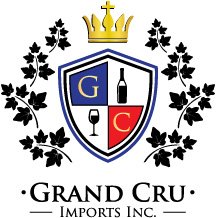5 reasons why when we think wine, we think of France
When you think wine, you are likely to think of France. But why is that? Is it because France (who wasn’t the first to cultivate wine) has been at it for so long — dating back to the 6th century BC with the colonization of Southern Gaul by Greek settlers, in fact?
Or perhaps when we think of wine, we think of France because it produces the most at 550 million cases a year, and then exports a third of its production, resulting in a 10 billion Euro a year industry?
The reasons for why when we think wine, we think of France are many. Here are five of our favourites.
1. Bordeaux is considered a world treasure
In 2007, prestigious vineyards of Bordeaux joined the ranks of the Pyramids of Giza and Canadian Rocky Mountain Parks when it received the designation by the United Nations Educational, Scientific and Cultural Organization (UNESCO) as a world heritage site. As a result of this designation, Bordeaux (and it’s 2,000-year-old role as the capital of a world-famous wine producing region) is seen as having universal cultural value and its conservation important to current and future generations.
Bordeaux by night taken by Juan Di Nella on Unsplash
2. France is the birthplace of Champagne
We had to shout out Champagne, a favourite wine at any Grand Cru Imports Inc. gathering. These bubbles are synonymous with France 's wine culture. When drinking Champagne you can be confident that the contents of your glass has to adhere to Méthode Champenoise, with grapes sourced from Champagne. Not to mention this region also has the great distinction of being on the UNESCO list of world heritage sites. Très magnifique!
Browse our premium selection Champagne on our merchant partner Marquis Wine Cellars’ website
3. The poetic way the French describe their wine
It’s in the way the French swish their glass gently prior to smelling the wine to take in the bouquet prior to having a sip. And it’s in the way the French look to see if the wine will pleurer (cry), dripping down the glass like teardrops of perfect consistency. It is commonly understood that if the wine doesn’t cry, perhaps it’s not very good wine. The French poetics continue, further describing their wine according to its robe, which literally means ‘dress’, which is a perfect fashion metaphor that embodies not only the idea of colour but also texture of the wine on the tongue.
4. The integrity of French wine (and many food products) is protected by the AOC
Appellation d’Origine Contrôlée, or AOC, is a French food-labeling term that refers to standards set to protect the style, ingredients, and origin of top tier products. Similar designations exist in many of Europe’s oldest food regions such as Italy’s DOC (Denominazione di Origine Controllata) and Spain’s DO (Denominación de Origen).
AOC includes 363 appellations for wine and spirits that include prominent wine regions of Bourgogne, Bordeaux and Champagne, which control everything from how the grapes are grown to what wine varieties are in the bottle.
Designations of AOC Wine
Within the AOC itself, you’ll find several designations that reflect location and quality. They are as follows:
Regional: This refers to the broadest sense of an AOC. Examples: Bordeaux, Burgundy.
Sub-Regional: Within those regions are smaller subregions known for more specific wine or terroir. Examples: Bordeaux’s Médoc sub-region, Burgundy’s Chablis sub-region.
Commune/Village: Narrowing further within a subregion, these areas are sometimes only a few miles in scope. Examples: Pauillac in Médoc, Côtes d’Auxerre in Chablis.
Special Classification: An AOC might be further specified for quality at this point, indicating a Cru, which refers to a specific vineyard or group of vineyards typically recognized for quality.
Above from Wine Folly’s Decoding French Wine Labels and Terms
Examples of AOC at play
Wines produced in Alsace, a varied regional terroir that borders both France and Germany, offer subtle differences in taste. The region produces a variety of grapes, primarily Riesling, Pinot Gris, Gewürztraminer, Auxxerois, Pinot Noir and Silvaner varieties. Most notable wines are the region’s Riesling, Pinot Gris as well as Gewürztraminer.
Wines bottled in Alsace are required to be bottled in the official bottle of the region called the flute, with most bottles including a grape variety of which the wine will be 100% composed. If no variety is labelled, it is likely a blend.
Roquefort cheese, one of the world’s best known blue cheeses, is a sheep milk cheese from Southern France. And due to its AOC’s designation, only those cheeses aged in the natural Combalou caves of Roquefort-sur-Soulzon may bear the name Roquefort.
When a product is labelled Haute-Provence Lavender Essential Oil, the consumer knows the product is a result of high-quality production concerning the essential oil of the finest lavender - Lavandula angustifolia. Additionally, this designation requires fields to be located within a specific territory at a minimum altitude of 800 meters. This geographic area covers 284 communities in the Alpes-de-Haute-Provence, Hautes-Alpes, Drôme and Vaucluse regions.
These regulations ensure the integrity of French wine and food for the consumer and producers alike.
5. French wines demand the highest prices in the world
If you were to review lists readily available for the most expensive wines in the world, they would have something in common, the majority of them would be from France. And for good reason! Great French wine is the product of centuries old chateaux, wine making methods and secrets that have been passed down generation to generation, resulting in an elixir synonymous with elegance, balance and precision.
Left: Domaine de la Romanée-Conti 1945 sold for the staggering price of $558,000—more than 17 times it’s original high estimate of $32,000.
Right: Chateau Margaux 1787 sold at auction was insured for $225,000.





